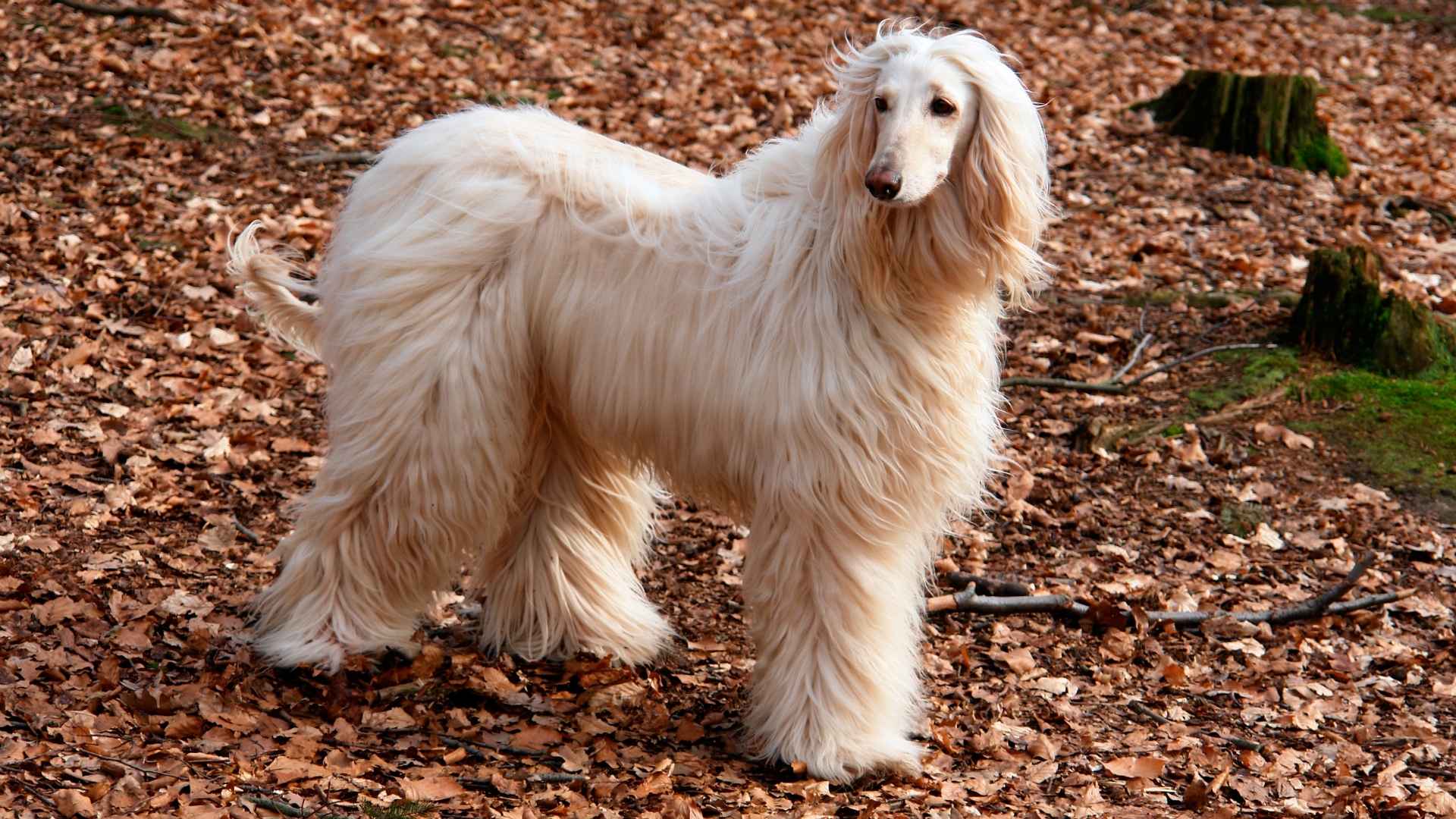For dog lovers with allergies, finding the right canine companion can be a delicate balance between heart and health. This challenge becomes even more complex when your preference leans toward extra-large breeds, dogs that offer not just loyalty and protection, but also a whole lot of fur. Fortunately, certain XL dog breeds are known to be hypoallergenic or low-shedding, making them more compatible with allergy-prone households.
It’s essential to clarify that “hypoallergenic” doesn’t mean allergy-proof. Rather, these breeds produce fewer allergens, especially in the form of dander, saliva, or shedding hair, and may be less likely to trigger reactions in sensitive individuals. For people who dream of snuggling up to a giant pup without sneezing through the experience, hypoallergenic dogs offer a more comfortable solution.
In this guide, we’ll explore big dog breeds that combine size and low-allergen traits. From shaggy, gentle giants to athletic working dogs with low-maintenance coats, these XL hypoallergenic breeds prove that you don’t have to sacrifice space or companionship for your health.
Hypoallergenic XL Dog Breeds
1. Airedale Terrier
The Airedale Terrier stands tall among its terrier cousins, earning the title “King of Terriers” due to its impressive size and dignified demeanor. Bred in England’s Aire Valley for versatility in hunting ducks and dispatching vermin, this breed is as capable as it is charming.
According to the AKC, the Airedale Terrier is sociable, brave, and intelligent. For allergy-conscious dog lovers, the Airedale offers a unique advantage: its coat sheds very little, making it a more manageable choice for those with sensitivities. While no dog is completely hypoallergenic, the Airedale’s low-shedding, dense coat can reduce the spread of dander in the home.
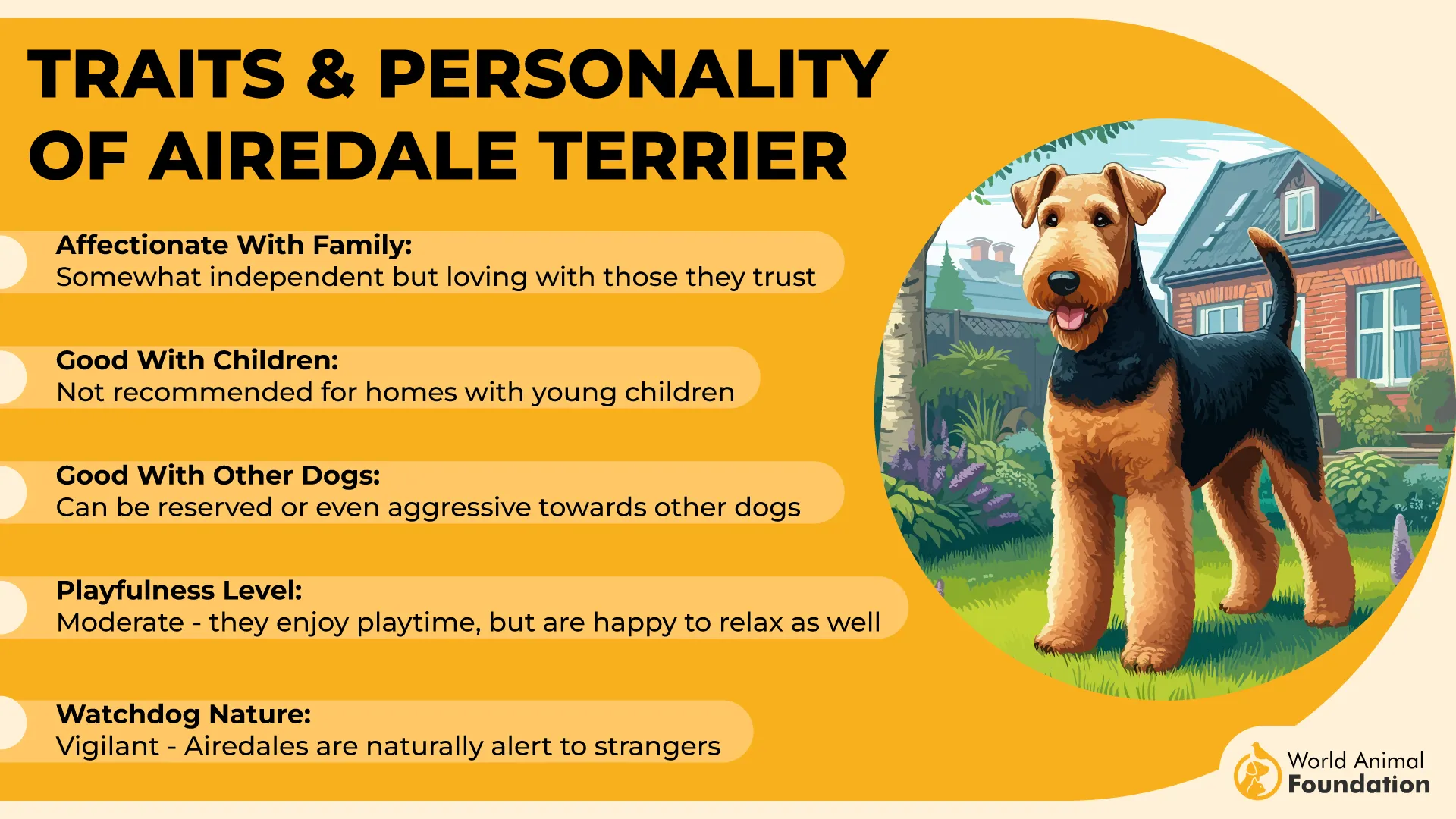
Grooming
Airedales have a distinctive wiry coat that requires regular upkeep to maintain its texture and appearance. Weekly brushing with a slicker brush helps remove loose hair and prevent tangles, while also minimizing allergens in the environment.
Professional grooming, including hand-stripping or clipping, should be scheduled three to four times per year. When well-maintained, their coats are less likely to trigger allergy symptoms, making them suitable for some allergy sufferers.
Fact: The Airedale Terrier’s coat can be straight, crinkled, or slightly wavy, and sheds very little throughout the year.
2. Afghan Hound
Few breeds showcase elegance and charm quite like the Afghan Hound. With a proud stance and a flowing, low-shedding coat, this XL breed is a stunning option for allergy-conscious dog lovers. Hills Pet mentions that the Afghan Hound is considered a demanding breed to care for due to several factors.
Their long, silky hair may suggest heavy shedding, but Afghans are actually among the breeds that shed minimally, making them a possible fit for those with sensitivities. Their aloof, self-assured demeanor can make them seem reserved, but with family, they can show surprising affection and loyalty.
Grooming
Despite their hypoallergenic appeal, Afghan Hounds demand a serious grooming commitment. Their luxurious coat requires frequent maintenance, expect to brush several times a week to prevent matting and tangles.
Regular bathing using quality shampoo and conditioner is essential to maintain their fine, flowing locks. Starting coat care early, especially as they transition from their fuzzy puppy coat to the sleek adult one, is vital for manageable upkeep.
Fact: Afghan Hounds originated thousands of years ago in the mountainous regions of present-day Afghanistan, India, and Pakistan, where they were revered as noble hunters and companions.
3. Portuguese Water Dog
Originally bred to assist fishermen along Portugal’s coast, the Portuguese Water Dog (PWD) has evolved into a loyal, lively companion with a natural talent for swimming and a coat designed for the sea. These athletic dogs were once tasked with herding fish into nets and delivering messages between boats, an energetic history that mirrors their spirited nature today.
PetMD notes that Portuguese Water Dogs are highly intelligent and easily trainable, which has made them reliable companions for generations. They are medium-to-large in size, typically standing up to 23 inches tall and weighing between 35 and 60 pounds, and are well-suited to active families who can match their boundless enthusiasm.
Grooming
One of the standout features of the Portuguese Water Dog is its hypoallergenic, waterproof coat. Whether curly or wavy, their dense fur sheds minimally, making them an excellent choice for allergy-prone households.
However, their hair requires consistent upkeep, weekly brushing to prevent tangles and matting, and professional grooming every four to eight weeks to maintain their coat’s health and texture. With regular care, their unique appearance and low-allergen fur make them a standout breed for families seeking a large dog with reduced shedding.
Fact: Portuguese Water Dogs gained widespread attention when Bo and Sunny became the first family dogs during the Obama administration.
4. Irish Water Spaniel
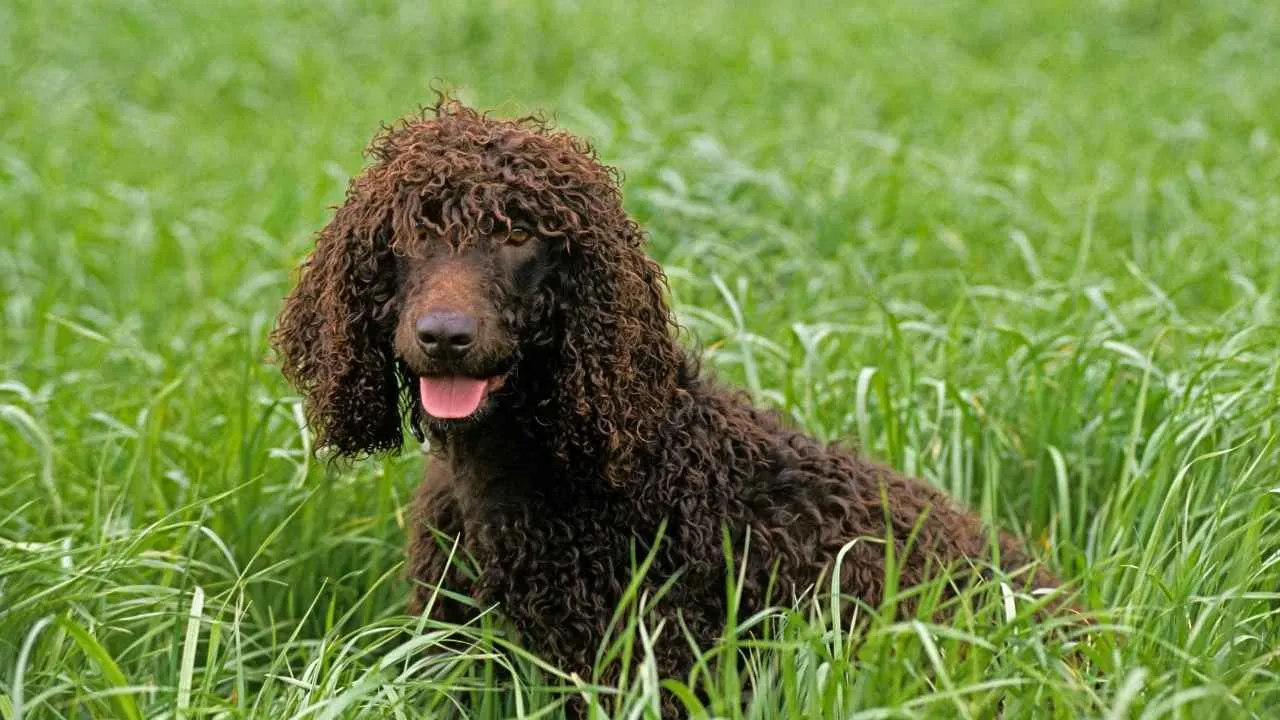
Curly-coated and full of energy, the Irish Water Spaniel is a unique and spirited breed that suits active families looking. Britannica states that the Irish Water Spaniel is a sporting breed that originated in Ireland in the 1830s, developed for retrieving game and descended from other curly-coated water retrievers. While affectionate and playful with its family, early socialization is key to ensuring it becomes confident and well-mannered around unfamiliar people and dogs.

Grooming
The Irish Water Spaniel’s dense, liver-colored curls are both eye-catching and functional. This low-shedding coat repels water and offers insulation during cold swims, making it ideal for retrieving in chilly marshes or lakes. While considered hypoallergenic, the coat does demand consistent care.
Frequent brushing prevents matting, and professional grooming every few weeks helps maintain the breed’s signature crisp curls and topknot. The smooth, hairless tail, nicknamed the “rat tail”, is a hallmark of the breed’s distinctive appearance.
Fact: The Irish Water Spaniel was officially recognized by the American Kennel Club in 1878.
5. Komondor
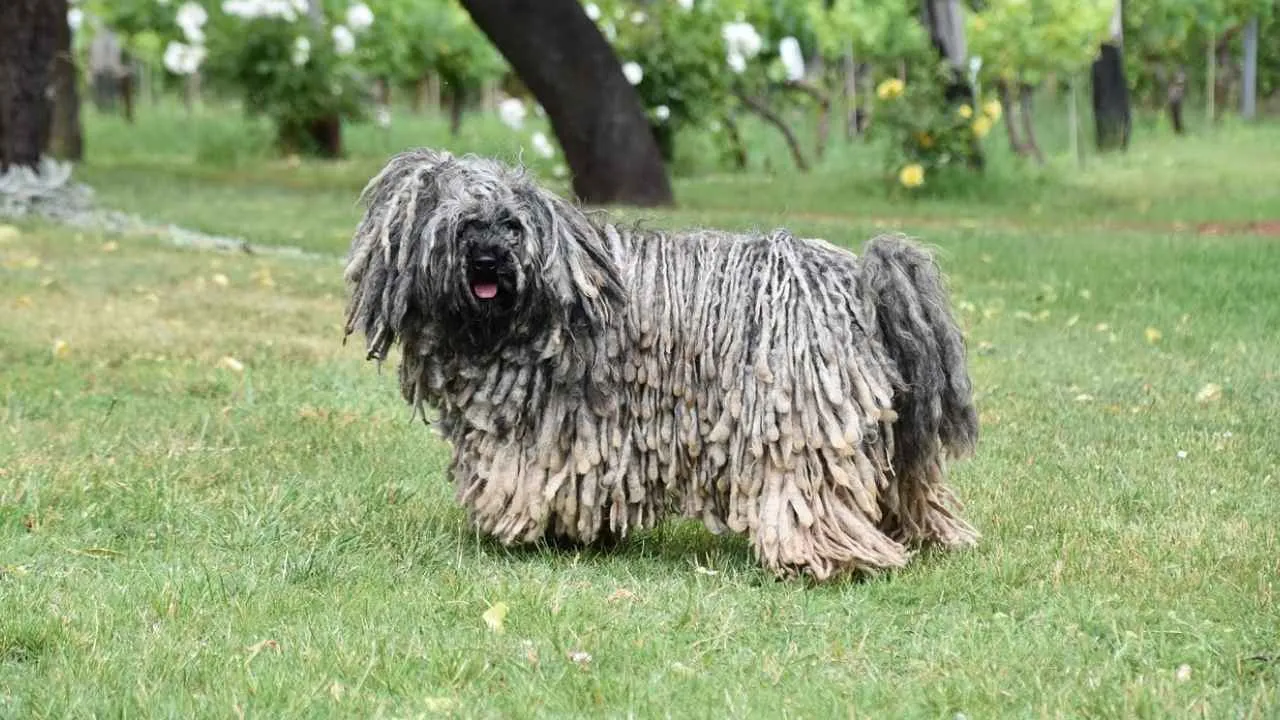
Originating from Hungary, this ancient breed has long served as a formidable livestock guardian, protecting sheep from predators while blending seamlessly into the flock. Its naturally corded coat develops into long, dense white dreadlocks that are more than just eye-catching; they also function as protective armor against harsh weather and even wolf attacks.
Because this breed doesn’t shed in the traditional sense, it’s often categorized as hypoallergenic, though its grooming demands are substantial.
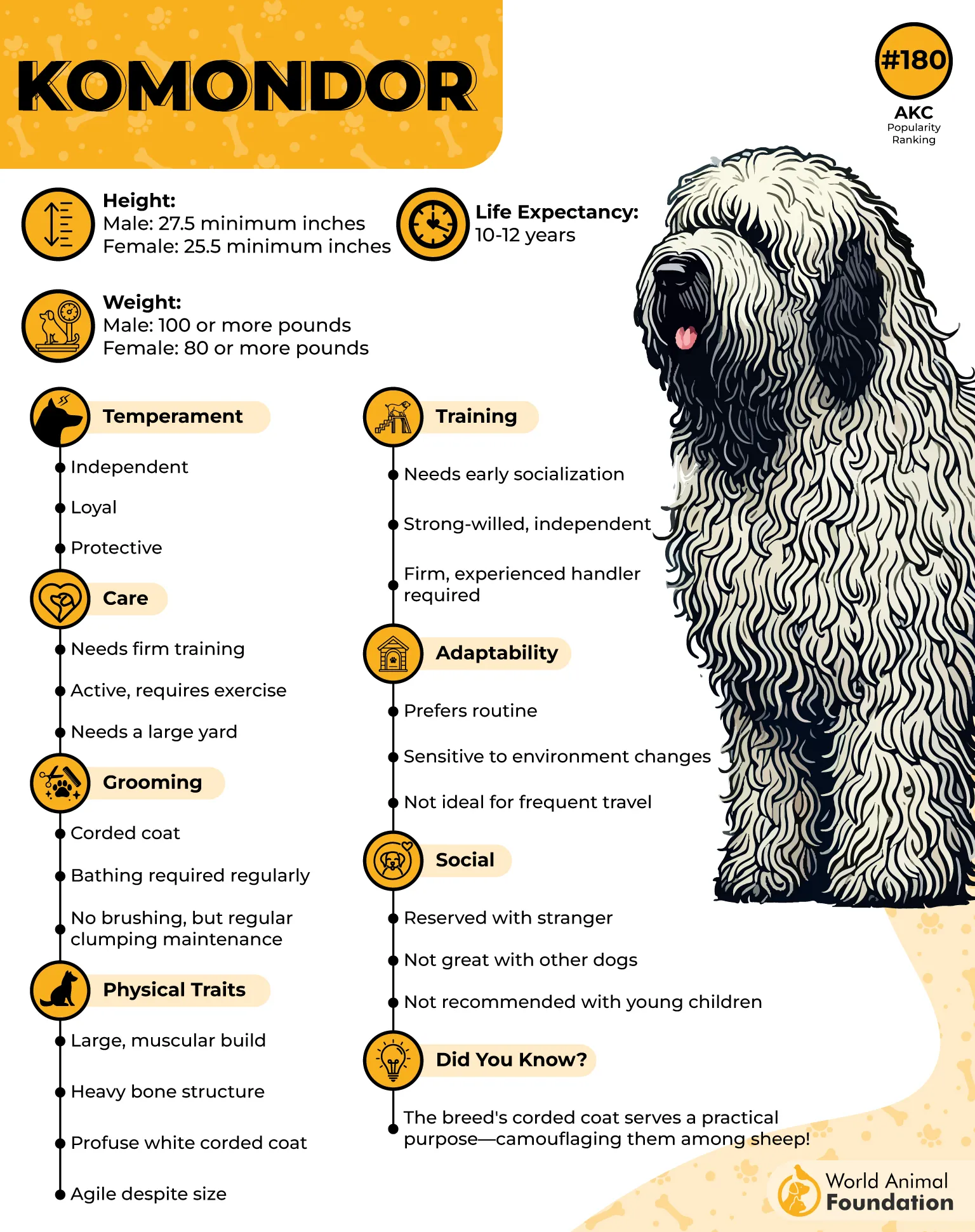
Grooming
Despite their low-shedding nature, Komondors require intensive grooming care. Their cords must be manually separated to avoid matting and must be kept meticulously clean and dry, as their dense coat can trap moisture and debris.
Regular bathing is a must, but drying the coat thoroughly can take hours. Owners should be prepared to dedicate significant time to coat maintenance or work with a groomer familiar with corded breeds.
Fact: The Komondor’s coat is so thick and durable that it served as natural protection against wolves during centuries of guarding Hungarian flocks.
6. Greyhound
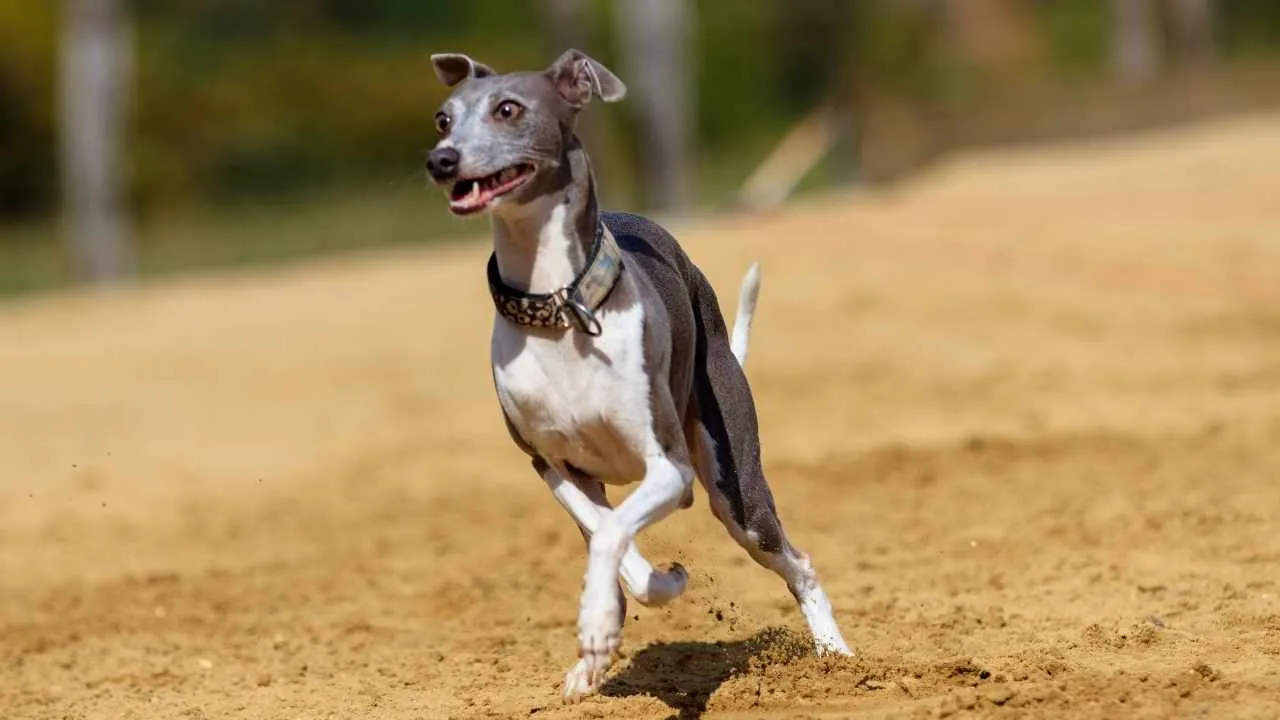
Known for their lightning-fast speed and lean frame, Greyhounds are more than just athletes; they’re also low-maintenance companions ideal for allergy-sensitive households. Despite their large size, they are surprisingly gentle and thrive in calm, loving environments.
Greyhounds form strong bonds with their families and get along well with respectful children. Their dignified and affectionate nature makes them well-suited for both active outings and cozy downtime on the couch.
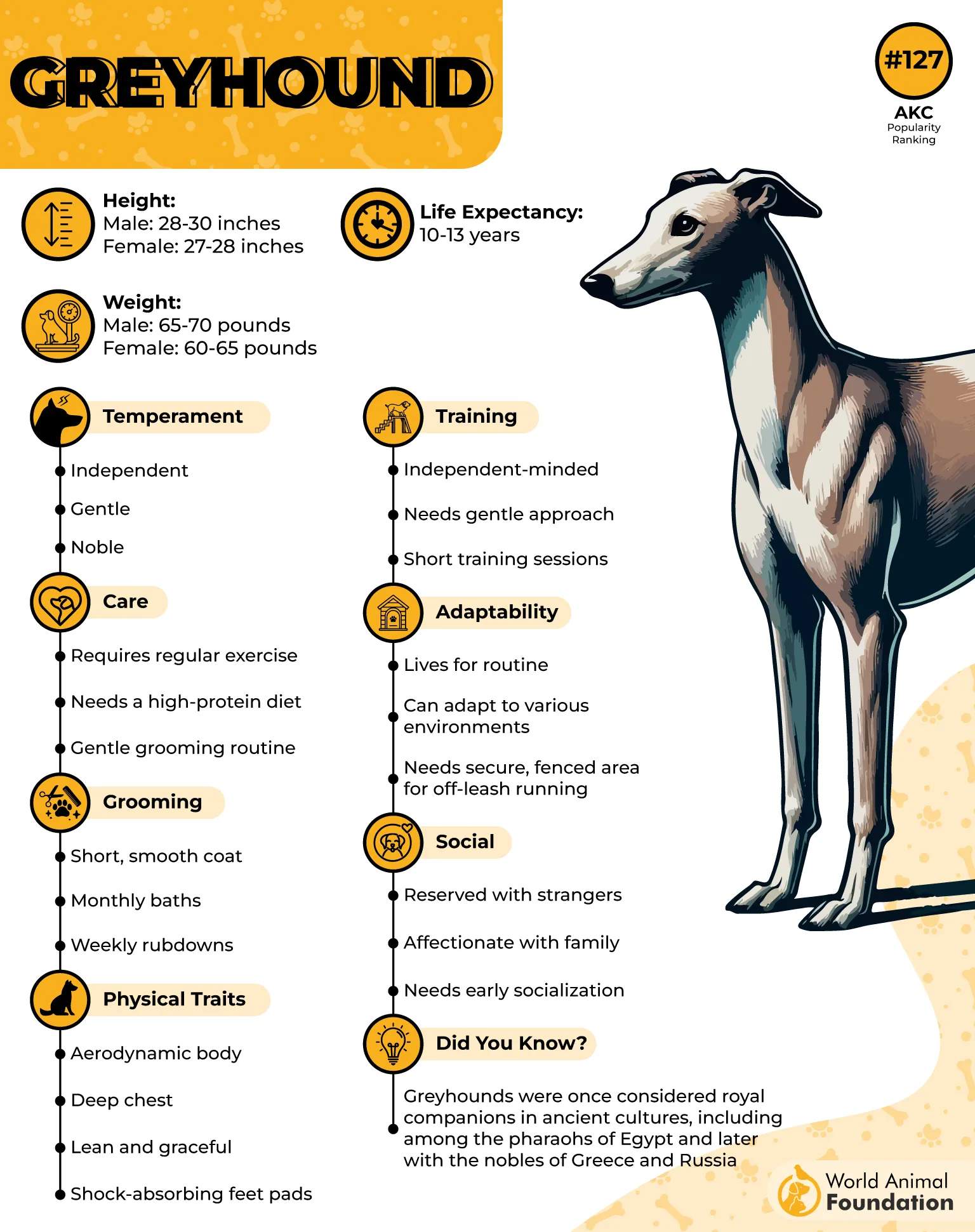
Grooming
While not entirely non-shedding, Greyhounds shed very minimally compared to other breeds of similar size. Their short, sleek coat doesn’t hold much loose fur, reducing the amount of pet dander released into the home.
Grooming is straightforward; occasional brushing and the occasional bath are usually sufficient to keep their coat clean and healthy. Additionally, Greyhounds are low-drooling, which can help reduce allergen exposure even further.
Fact: Greyhounds stand 27 to 30 inches tall and weigh between 60 and 70 pounds, yet their short coats come in nearly every color imaginable.
7. Barbet
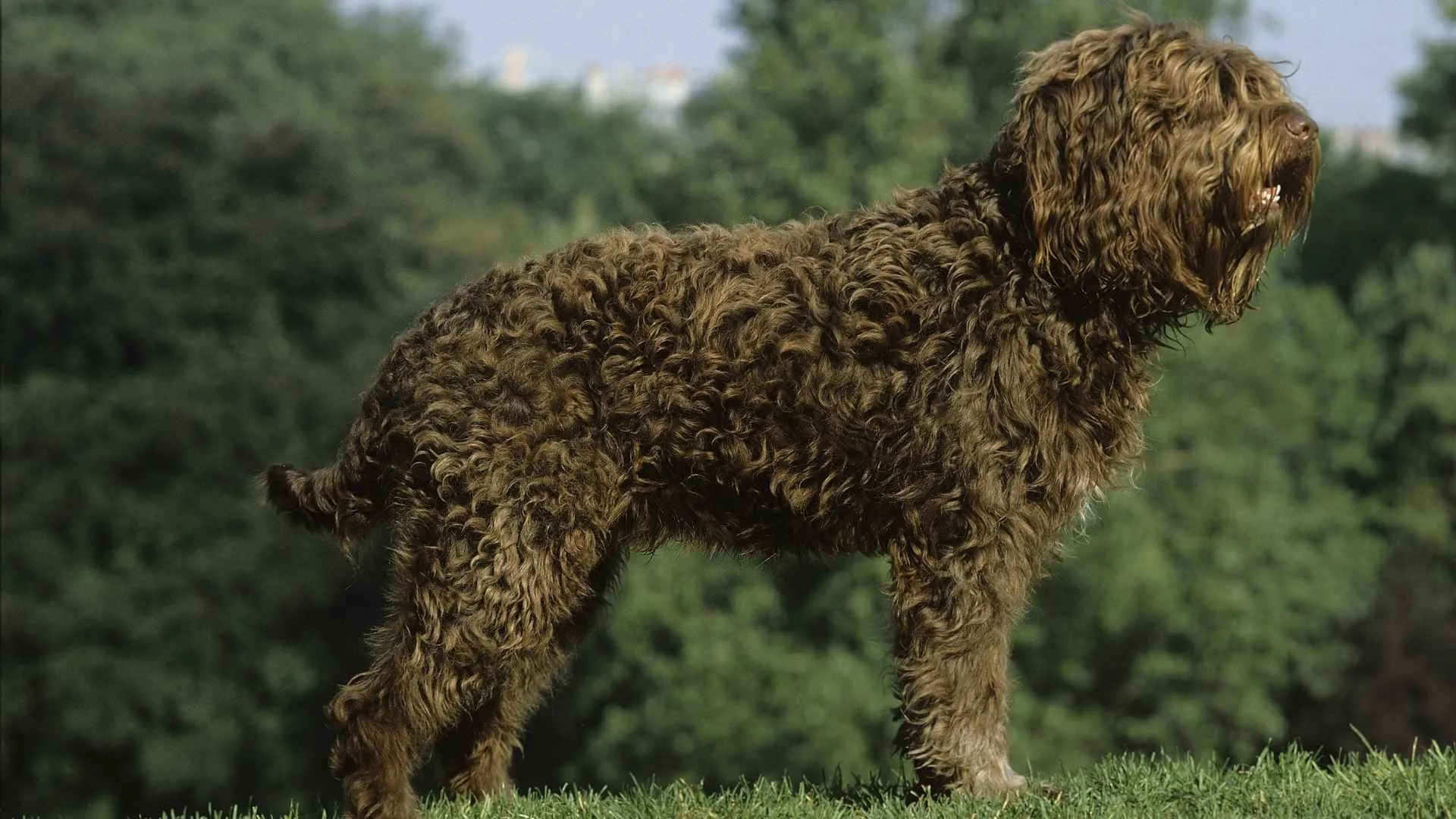
It is one of France’s oldest water dogs. This medium-to-large breed is known for its curly, wool-like coat that sheds minimally. Barbets are cheerful, affectionate companions with a keen love for swimming and outdoor adventures. They are social by nature and thrive in active families that can match their need for daily mental and physical stimulation.
Grooming
Though low-shedding, the Barbet’s dense, curly coat demands consistent care to stay in top condition. Daily brushing and combing are necessary to prevent matting, especially down to the skin. After bathing, blow-drying helps straighten the coat for a trim, ideally keeping the body hair at 3 to 5 inches while leaving the head and tail longer. Regular nail clipping, ear checks, and dental care are essential for overall well-being.
Fact: The Barbet’s distinct bearded face and curly coat have been depicted in French art since the 16th century, highlighting its long-standing heritage.
8. Giant Schnauzer
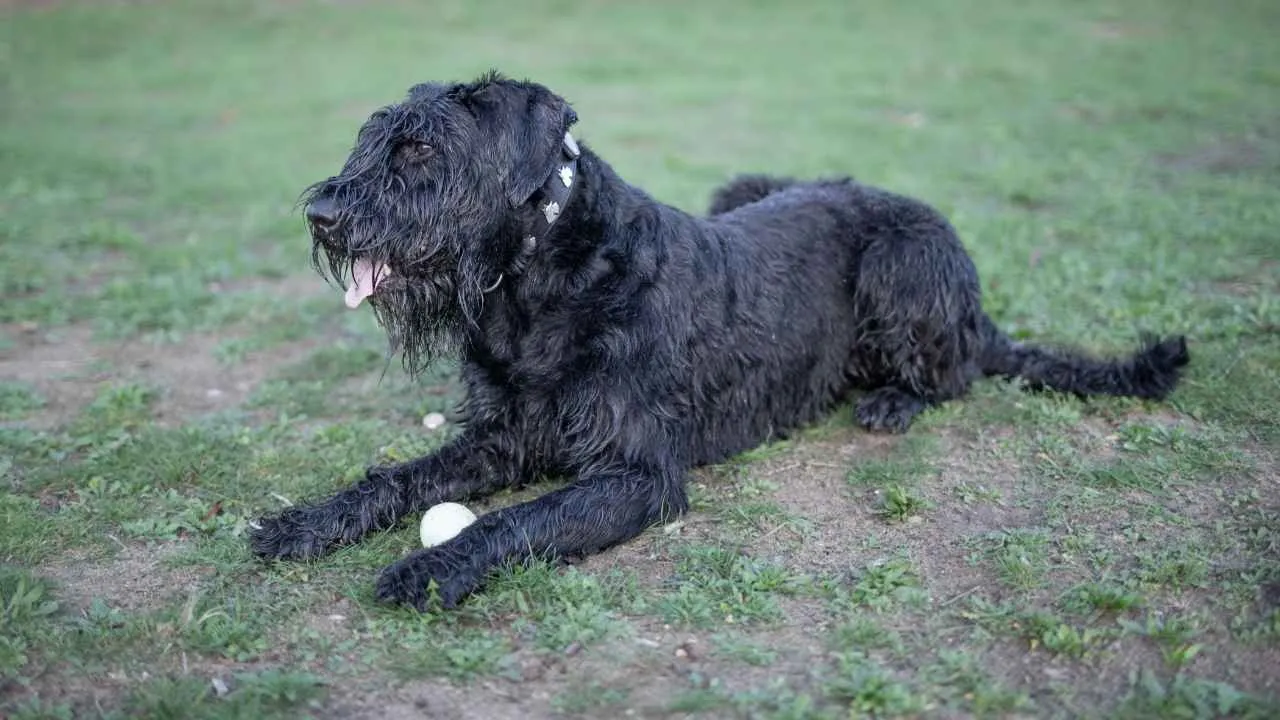
The Giant Schnauzer stands out as an imposing, intelligent, and hypoallergenic breed ideal for active households. Originally developed in Germany as a cattle-driving and guarding dog, this robust XL breed evolved from the Standard Schnauzer, inheriting its strength and trademark expressive features, most notably its distinctive beard and eyebrows.
Although they are powerful and bold, Giant Schnauzers are deeply loyal and highly trainable, thriving when given meaningful tasks or structured routines.
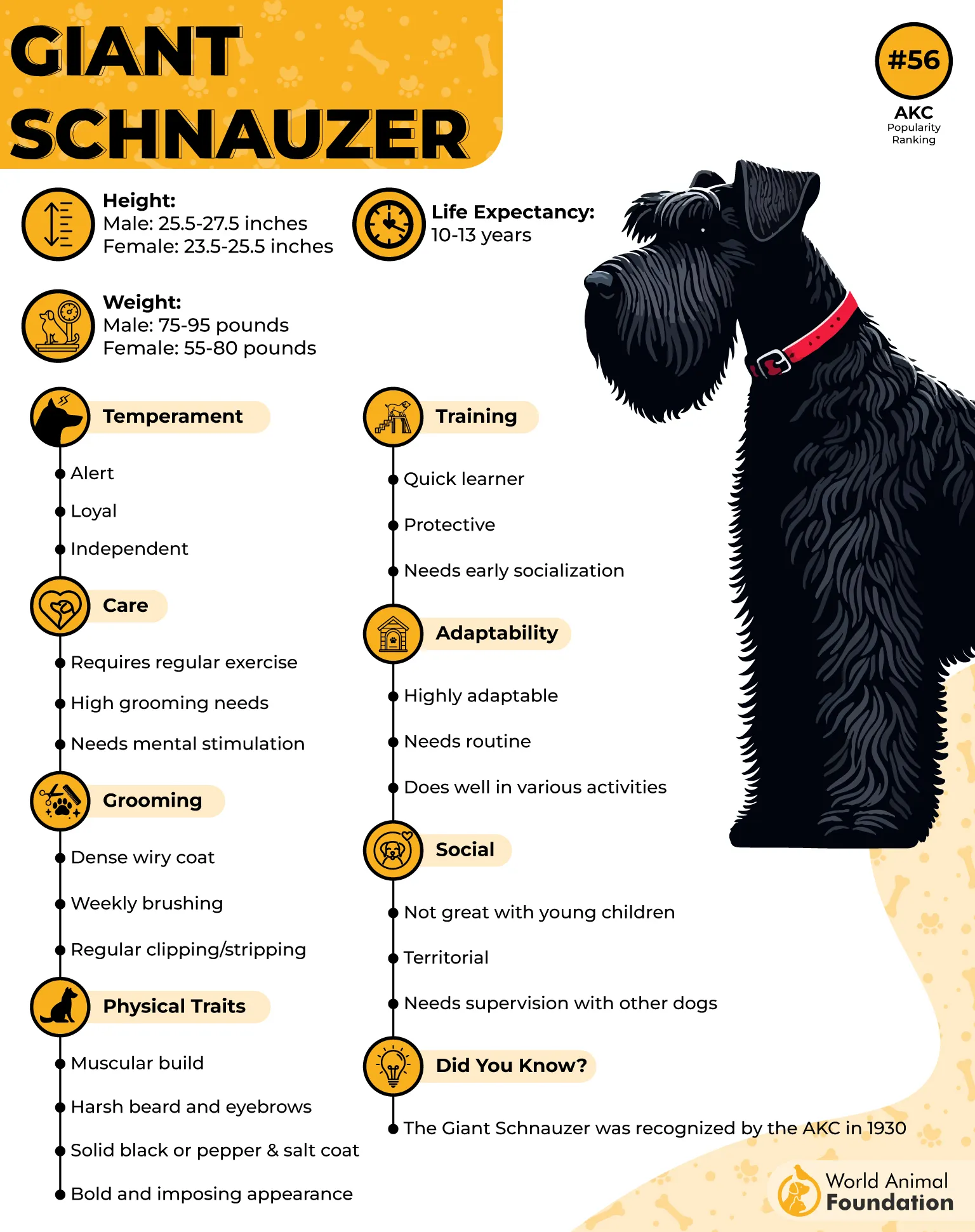
Grooming
Despite their thick double coat, this large hypoallergenic dog sheds very little, making them a smart pick for allergy-sensitive families. Their wiry, weather-resistant coat requires regular upkeep: weekly brushing helps remove debris and prevent matting, while professional grooming or hand-stripping every few weeks keeps the coat in optimal condition. Routine ear checks and dental hygiene are also recommended for overall health.
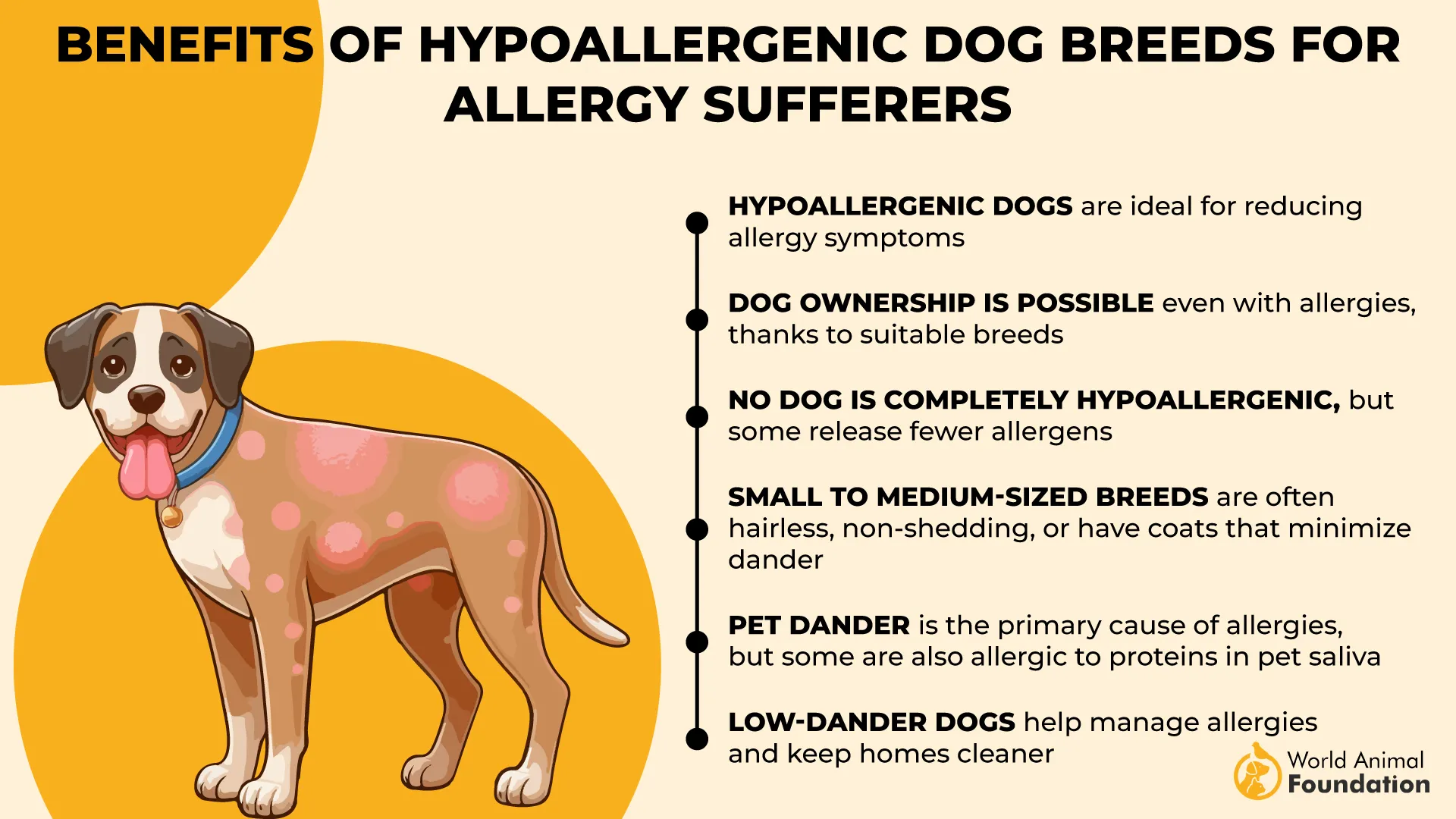
Fact: The Giant Schnauzer’s coat, either solid black or salt and pepper, is one of the key reasons this bold and loyal dog is considered hypoallergenic.
9. Goldendoodle
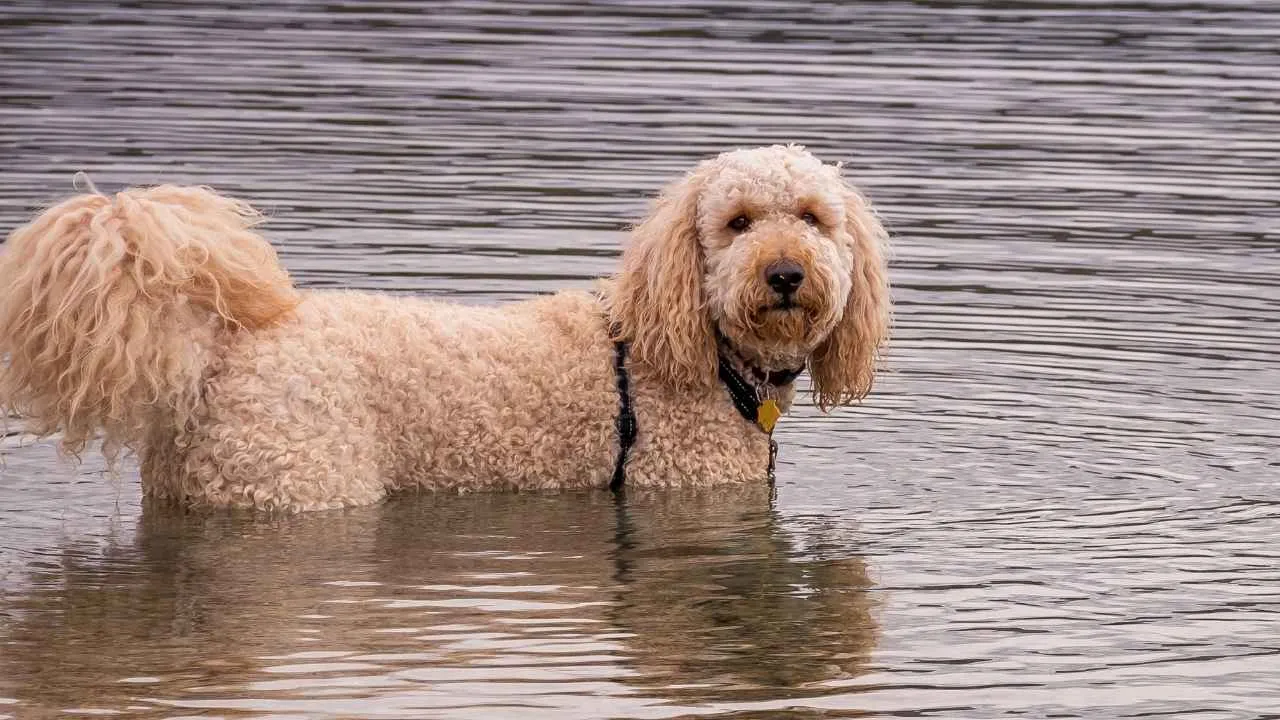
Combining the best traits of the Golden Retriever and the Poodle, the Goldendoodle is an intelligent, affectionate, and high-energy hybrid that excels as a family companion. These sociable dogs thrive on interaction and make great playmates for children and other pets.
While their friendly temperament and loyalty are widely celebrated, their hypoallergenic qualities are also a major appeal, especially for households seeking a large dog with minimal shedding. Due to their need for companionship, Goldendoodles may develop separation anxiety if left alone too long, making consistent social engagement a must.
Grooming
The Goldendoodle’s coat varies in texture depending on which parent breed is more dominant. Those with curlier, more Poodle-like coats tend to shed less and are better suited for allergy-sensitive owners. However, their low-shedding fur still requires regular maintenance.
Brushing several times a week prevents matting, and professional grooming every 6–8 weeks is often necessary to manage their fluffy, often multi-colored coats. Their grooming needs are a key factor in maintaining their hypoallergenic reputation.
Fact: Originally bred in the late 1960s as a guide dog, the Goldendoodle gained popularity in the 1990s for being intelligent, low-shedding, and highly trainable.
10. Bouvier Des Flandres

The Bouvier des Flandres is a large, sturdy working dog with a calm yet protective nature. While their powerful frame may seem imposing, they’re known to be affectionate companions, especially for experienced dog owners. Originally bred for herding and farm work in Belgium, this intelligent breed thrives in environments where it’s given a purpose.
Grooming
Though considered hypoallergenic due to their low-shedding double coat, Bouviers require a significant grooming commitment. Weekly brushing is essential to prevent mats and tangles, often taking over an hour to do thoroughly.
Many owners opt to trim the dog’s beard and body fur for easier upkeep. Monthly baths and regular ear cleaning help maintain overall hygiene and reduce allergens. Nail trims every few weeks are also recommended to prevent discomfort.
Fact: The Bouvier des Flandres is a rare breed in the U.S., and prospective owners should seek out reputable breeders who perform health screenings on parent dogs.
Conclusion
Choosing a hypoallergenic XL breed can be life-changing for families who adore big dogs but worry about dog allergies. While no dog is completely allergen-free, some large breeds, like the Greyhound, produce less dander and shed minimally, making them ideal low-shedding dogs. These breeds often have coats that require less maintenance and create fewer allergy triggers, especially when paired with regular grooming routines.
If you love gentle giants but fear allergic reactions, options do exist beyond the commonly cited dogs that don’t shed. While breeds like the Bernese Mountain Dog are known for their beauty and loyalty, they may not be the best match for allergy-prone households due to their thick, shedding coats. However, exploring hypoallergenic traits in other dogs, such as low drool levels and minimal dander, can help you find the perfect extra-large canine companion without sacrificing your comfort or health.


